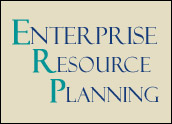
Businesses decide to invest in enterprise resource planning systems for a number of reasons, but it all boils down to one main benefit: profits. ERP systems streamline data processes and eliminate waste to create the most efficient company possible, leaving more room to get things done and turn a healthy profit. There’s no shame in admitting that a business is revenue-driven, and that ERP is designed to hike revenues even higher than many businesses thought possible. With the right ERP system, a good business can become a great business.
However, it’s no secret that deciding to implement an ERP system carries some risks. Investing in ERP requires a significant upfront investment in both time and money, and mishandling the implementation process can have negative effects on a company that didn’t plan well for the changes that ERP can bring.
Luckily, it’s easy for any business owner to take a few small steps that will help ensure his or her company ends up reaping all the benefits ERP has to offer. Paying attention to detail, planning in advance and resisting the temptation to cut corners will help executives make their ERP investments worthwhile.
1. Learn. Before investing in ERP, it’s crucial that business owners understand all the ins and outs of their own companies. Knowing how the enterprise works will help an executive see where ERP can eliminate double data entry, streamline processes, and work to make the company more efficient. Understanding how the business functions is fundamental to choosing the right ERP system and implementing that system in the most beneficial way.
2. Plan. It may sound simple, but too many business owners think that they can simply “wing it” when it comes to ERP. The truth is that deciding to just tackle problems as they arise is much less effective than planning for potential issues and handling stressful situations long before they erupt into major ERP mishaps.
Planning means making — and sticking to — schedules. If business owners want their ERP implementation projects to run smoothly, they will need to set deadlines for each step of the process, block out days for training, and have a backup plan in case the implementation process takes longer or costs more than expected. Having these kinks worked out before you embark on your ERP implementation process is a great way to stay on track toward ERP success.
3. Budget. As any good investor knows, high risks signal enormous potential for rewards. ERP can be a big financial risk, but it can offer great financial rewards when successful. That’s why the most crucial step toward becoming an ERP success story is budgeting appropriately.
Many ERP projects go way over their budgets, cost thousands more than expected, and end up falling by the wayside, uncompleted and idle, reaping no benefits. To avoid this trap, business owners interested in ERP should be careful to calculate all the costs, hidden and obvious, of investing in ERP — including not just the initial software costs but also the maintenance, upgrade and training fees, which can add up.
Total cost of ownership, or TCO, is a useful tool in determining this figure and budgeting accordingly.
4. Train. Another major cause of ERP failure is employees who either don’t know or don’t care how to work the new system. It’s natural for employees to feel some resistance to change, and executives should even expect it. That’s why it’s so critical to make sure employees are properly trained in managing the new system. Employees who feel prepared to tackle ERP are less likely to report being disgruntled or unhappy with the new system.
In addition, well-trained employees come in prepared to work with ERP, thereby eliminating some of the awkwardness that can occur when adjusting to a new system.
You wouldn’t let somebody operate a car without sending them to driver’s ed. Likewise, don’t let your employees work with ERP until they’ve been thoroughly trained in how to do so properly.
5. Commit. Business owners who are only partially committed to their ERP projects are setting themselves up for failure. ERP requires a good deal of investment — both fiscal and emotional. ERP will need to become a major priority for the company if it wants the system to pay off in the end.
6. Follow through. Handling ERP doesn’t end when the implementation process is over. Like any other software, ERP is evolving at a rapid pace and requires frequent maintenance and upgrades to perform at its best. Keeping track of upgrades and installing them in a timely manner, as well as following through with all scheduled maintenance, will have you enjoying the benefits of ERP success for years.
Investing in ERP is risky, but it carries the promise of great rewards if done correctly. Following these steps is one way that business owners can work to ensure that their own ERP stories will be successful ones.
Erik Kaas is director of product management for mid-market ERP products at Sage .











































